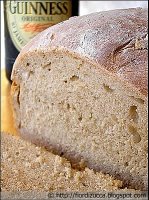Italian Carnival Traditions - Smacafam – Kill the Hunger!
 While many Italian Carnival Traditions make mock versions of traditional dishes, just as the costumes transform a normally quiet individual into a Don Giovanni, in Trentino a cake is made with a local pork sausage, pancetta and lard. The name, in local dialect, means Hunger Killer! The origins of the savory bread cake are not apparent most surely this is an antique recipe. Most scholars agree that the recipe dates well into the period of the Roman Empire. The first mention is in a cookbook written in the III century.
While many Italian Carnival Traditions make mock versions of traditional dishes, just as the costumes transform a normally quiet individual into a Don Giovanni, in Trentino a cake is made with a local pork sausage, pancetta and lard. The name, in local dialect, means Hunger Killer! The origins of the savory bread cake are not apparent most surely this is an antique recipe. Most scholars agree that the recipe dates well into the period of the Roman Empire. The first mention is in a cookbook written in the III century.Trentino is located in the Alps. During the winter months it is cold, really cold and many of the locals would spend extended periods of time away from the shelter of the local town. A cake like this would be highly efficient when, carrying around a lot weight or bulky materials in the mountain passes would not have been the most intelligent of choices.
 No matter where or when this combination of savory flavors and consistency was first put together it is a fantastic dish. Some recipes are timeless and reach across culinary boundaries like the Casatiello. I was even amazed to find that every American Italian Chef who has published a book or has a show, including the Food Network, presents his/her own version of this traditional Carnival specialty. This is unusual because not many dishes from Trentino make into internationally known cookbooks. Attention however, many of these recipes talk about Italian Sausage. In the US Italian Sausage is not really Italian. It is southern Italian and does not have Parmesan or Stracchino cheese and includes Fennel and other southern cooking herbs. The closest commercial product to the Lucanica or other Northern Italian sausages is Bratwurst. While Bratwurst does not use Parmesan cheese it does use nutmeg, cloves, and pepper.
No matter where or when this combination of savory flavors and consistency was first put together it is a fantastic dish. Some recipes are timeless and reach across culinary boundaries like the Casatiello. I was even amazed to find that every American Italian Chef who has published a book or has a show, including the Food Network, presents his/her own version of this traditional Carnival specialty. This is unusual because not many dishes from Trentino make into internationally known cookbooks. Attention however, many of these recipes talk about Italian Sausage. In the US Italian Sausage is not really Italian. It is southern Italian and does not have Parmesan or Stracchino cheese and includes Fennel and other southern cooking herbs. The closest commercial product to the Lucanica or other Northern Italian sausages is Bratwurst. While Bratwurst does not use Parmesan cheese it does use nutmeg, cloves, and pepper.An additional note is that some “famous” recipes use a mix of buckwheat and flour instead of simple buckwheat and milk instead of meat or chicken broth. Some say these differences are a sacrilege others believe this is the way it has always been. The choice is yours.
Ingredients:
¼ onion minced
2 ¼ cups (300 g) Buckwheat Flour (some recipes use 100 g buckwheat 200 g all-purpose)
2 (4 oz) Lucanica (Bratwurst or Northern Italian Sausage)
2 slices (1 oz) (thick cut into pieces) Lard, Pancetta or Bacon
2 ¼ cups (500 ml) cold Meat or Chicken Broth (some recipes use milk instead of Broth)
3 tbsp Olive Oil
 Preparation:
Preparation:Sift together the flour and salt into a large mixing bowl.
Preheat the oven to 375 degrees. Grease a large baking pan with Olive Oil.
In a skillet, place the Olive Oil, minced onions and lard (or pancetta, bacon). Cook over low heat for 4 minutes until the onion is translucent. Remove from heat and allow the mixture to cool completely.
While stirring the flour slowly pour in the broth. Mix in the onion-lard mixture and pour into the baking dish.
Remove the casing from the sausage and cut into disks. Distribute the disks evenly across the top of the dough.
Place in the oven and cook the salted cake for 40 minutes.
Remove and allow to cool before serving.
Tags: Holiday Traditions Carnival Italian Recipes Trentino Italain Holidays Marti Gras Travel Italy
Labels: Carnevale, Gourmet Foods, Holiday Traditions, Italian Desserts, Italian Holidays, Italian Recipes, Trentino




























